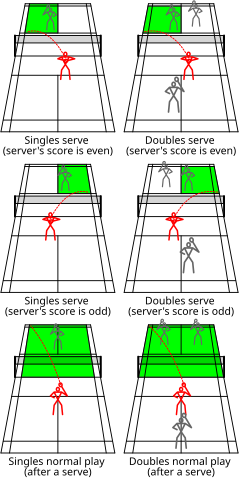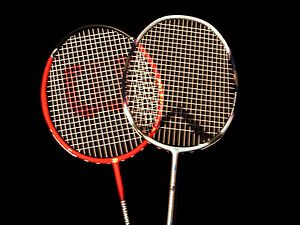Football may refer to one of a number of team sports which all involve, to varying degrees, kicking a ball with the foot to score a goal. The most popular of these sports worldwide is association football, more commonly known as just "football" or "soccer". Unqualified, the word football applies to whichever form of football is the most popular in the regional context in which the word appears, including American football, Australian rules football, Canadian football, Gaelic football, rugby league, rugby union and other related games. These variations of football are known as football "codes".
Common Elements
The various codes of football share the following common elements:
- Two teams of usually between 11 and 18 players; some variations that have fewer players (five or more per team) are also popular.
- A clearly defined area in which to play the game.
- Scoring goals or points, by moving the ball to an opposing team's end of the field and either into a goal area, or over a line.
- Goals or points resulting from players putting the ball between two goalposts.
- The goal or line being defended by the opposing team.
- Players being required to move the ball—depending on the code—by kicking, carrying, or hand-passing the ball.
- Players using only their body to move the ball.
Peoples from around the world have played games which involved kicking or carrying a ball, since ancient times. However, most of the modern codes of football have their origins in England.
Early History

The Ancient Greeks and Romans are known to have played many ball games, some of which involved the use of the feet. The Roman game harpastum is believed to have been adapted from a Greek team game known as "ἐπίσκυρος" (episkyros)[3][4] or "φαινίνδα" (phaininda),[5] which is mentioned by a Greek playwright, Antiphanes (388–311 BC) and later referred to by the Christian theologian Clement of Alexandria (c.150-c.215 AD). These games appear to have resembled rugby football.[6][7][8][9][10] The Roman politician Cicero (106–43 BC) describes the case of a man who was killed whilst having a shave when a ball was kicked into a barber's shop. Roman ball games already knew the air-filled ball, the follis.[11][12]
Documented evidence of an activity resembling football can be found in the Chinese military manual Zhan Guo Ce compiled between the 3rd century and 1st century BC.[13] It describes a practice known as cuju (蹴鞠, literally "kick ball"), which originally involved kicking a leather ball through a small hole in a piece of silk cloth which was fixed on bamboo canes and hung about 9 m above ground. During the Han Dynasty (206 BC–220 AD), cuju games were standardized and rules were established. Variations of this game later spread to Japan and Korea, known as kemari and chuk-guk respectively. Later, another type of goal posts emerged, consisting of just one goal post in the middle of the field.
The Japanese version of cuju is kemari (蹴鞠), and was developed during the Asuka period. This is known to have been played within the Japanese imperial court in Kyoto from about 600 AD. In kemari several people stand in a circle and kick a ball to each other, trying not to let the ball drop to the ground (much like keepie uppie). The game appears to have died out sometime before the mid-19th century. It was revived in 1903 and is now played at a number of festivals.
There are a number of references to traditional, ancient, or prehistoric ball games, played by indigenous peoples in many different parts of the world. For example, in 1586, men from a ship commanded by an English explorer named John Davis, went ashore to play a form of football with Inuit (Eskimo) people in Greenland.[15] There are later accounts of an Inuit game played on ice, called Aqsaqtuk. Each match began with two teams facing each other in parallel lines, before attempting to kick the ball through each other team's line and then at a goal. In 1610, William Strachey, a colonist at Jamestown, Virginia recorded a game played by Native Americans, called Pahsaheman. On the Australian continent several tribes of indigenous people played kicking and catching games with stuffed balls which have been generalised by historians as Marn Grook (Djab Wurrung for "game ball"). The earliest historical account is an anecdote from the 1878 book by Robert Brough-Smyth, The Aborigines of Victoria, in which a man called Richard Thomas is quoted as saying, in about 1841 in Victoria, Australia, that he had witnessed Aboriginal people playing the game: "Mr Thomas describes how the foremost player will drop kick a ball made from the skin of a possum and how other players leap into the air in order to catch it." Some historians have theorised that Marn Grook was one of the origins of Australian rules football.
The Māori in New Zealand played a game called Ki-o-rahi consisting of teams of seven players play on a circular field divided into zones, and score points by touching the 'pou' (boundary markers) and hitting a central 'tupu' or target.
Games played in Mesoamerica with rubber balls by indigenous peoples are also well-documented as existing since before this time, but these had more similarities to basketball or volleyball, and since their influence on modern football games is minimal, most do not class them as football. Northeastern American Indians, especially the Iroquois Confederation, played a game which made use of net racquets to throw and catch a small ball; however, although a ball-goal foot game, lacrosse (as its modern descendant is called) is likewise not usually classed as a form of "football."
These games and others may well go far back into antiquity. However, the main sources of modern football codes appear to lie in western Europe, especially England.
Medieval And Early Modern Europe

The Middle Ages saw a huge rise in popularity of annual Shrovetide football matches throughout Europe, particularly in England. The game played in England at this time may have arrived with the Roman occupation, but the only pre-Norman reference is to boys playing "ball games" in the 9th century Historia Brittonum. Reports of a game played in Brittany, Normandy, and Picardy, known as La Soule or Choule, suggest that some of these football games could have arrived in England as a result of the Norman Conquest.
The first detailed description of what was almost certainly football in England was given by William FitzStephen in about 1174–1183. He described the activities of London youths during the annual festival of Shrove Tuesday:
- After lunch all the youth of the city go out into the fields to take part in a ball game. The students of each school have their own ball; the workers from each city craft are also carrying their balls. Older citizens, fathers, and wealthy citizens come on horseback to watch their juniors competing, and to relive their own youth vicariously: you can see their inner passions aroused as they watch the action and get caught up in the fun being had by the carefree adolescents.[16]
An early reference to a ball game that was probably football comes from 1280 at Ulgham, Northumberland, England: "Henry... while playing at ball.. ran against David".[17] Football was played in Ireland in 1308, with a documented reference to John McCrocan, a spectator at a "football game" at Newcastle, County Down being charged with accidentally stabbing a player named William Bernard.[18] Another reference to a football game comes in 1321 at Shouldham, Norfolk, England: "[d]uring the game at ball as he kicked the ball, a lay friend of his... ran against him and wounded himself".[17]
In 1314, Nicholas de Farndone, Lord Mayor of the City of London issued a decree banning football in the French used by the English upper classes at the time. A translation reads: "[f]orasmuch as there is great noise in the city caused by hustling over large foot balls [rageries de grosses pelotes de pee] in the fields of the public from which many evils might arise which God forbid: we command and forbid on behalf of the king, on pain of imprisonment, such game to be used in the city in the future." This is the earliest reference to football.
In 1363, King Edward III of England issued a proclamation banning "...handball, football, or hockey; coursing and cock-fighting, or other such idle games", showing that "football" — whatever its exact form in this case — was being differentiated from games involving other parts of the body, such as handball.
King Henry IV of England also presented one of the earliest documented uses of the English word "football", in 1409, when he issued a proclamation forbidding the levying of money for "foteball".[17][19]
There is also an account in Latin from the end of the 15th century of football being played at Cawston, Nottinghamshire. This is the first description of a "kicking game" and the first description of dribbling: "[t]he game at which they had met for common recreation is called by some the foot-ball game. It is one in which young men, in country sport, propel a huge ball not by throwing it into the air but by striking it and rolling it along the ground, and that not with their hands but with their feet... kicking in opposite directions" The chronicler gives the earliest reference to a football pitch, stating that: "[t]he boundaries have been marked and the game had started.[17]
Other firsts in the mediæval and early modern eras:
- "a football", in the sense of a ball rather than a game, was first mentioned in 1486.[19] This reference is in Dame Juliana Berners' Book of St Albans. It states: "a certain rounde instrument to play with ...it is an instrument for the foote and then it is calde in Latyn 'pila pedalis', a fotebal."[17]
- a pair of football boots was ordered by King Henry VIII of England in 1526.[20]
- women playing a form of football was in 1580, when Sir Philip Sidney described it in one of his poems: "[a] tyme there is for all, my mother often sayes, When she, with skirts tuckt very hy, with girles at football playes."[21]
- the first references to goals are in the late 16th and early 17th centuries. In 1584 and 1602 respectively, John Norden and Richard Carew referred to "goals" in Cornish hurling. Carew described how goals were made: "they pitch two bushes in the ground, some eight or ten foote asunder; and directly against them, ten or twelue [twelve] score off, other twayne in like distance, which they terme their Goales".[22] He is also the first to describe goalkeepers and passing of the ball between players.
- the first direct reference to scoring a goal is in John Day's play The Blind Beggar of Bethnal Green (performed circa 1600; published 1659): "I'll play a gole at camp-ball" (an extremely violent variety of football, which was popular in East Anglia). Similarly in a poem in 1613, Michael Drayton refers to "when the Ball to throw, And drive it to the Gole, in squadrons forth they goe".


